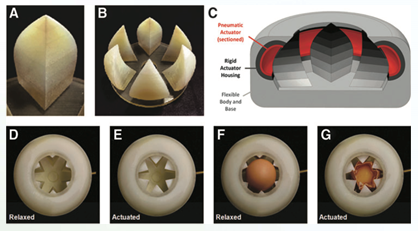A Biologically Inspired, Functionally Graded End Effector
for Soft Robotics Applications
Hybrid End Effector Design
(A-C) The design consists of six radially arranged functionally graded tooth-like elements surrounded by an embedded pneumatic actuator. (D-G) Actuation of the end effector in the absence and presence of an egg, demonstrating the ability of this system to apply highly concentrated point loads.

Kumar, K.; Liu, J.; Christianson, C.; Ali, M.; Tolley, M. T.; Aizenberg, J.; Ingber, D.E.; Weaver, J.C.; Bertoldi, K. "A Biologically Inspired, Functionally Graded End Effector for Soft Robotics Applications", Soft Robotics (2017) ![]()
![]()
Soft robotic actuators offer many advantages over their rigid counterparts, but they often are unable to apply highly localized point loads. In contrast, many soft bodied invertebrates have evolved extremely strong "hybrid appendages" consisting of rigid and flexible components that are both highly compliant and resilient. In an experimental and theoretical collaboration at the Harvard MRSEC, Aizenberg and Bertoldi have demonstrated a synthetic hybrid end effector for soft-bodied robots that exhibits excellent piercing abilities. This hybrid architecture seamlessly integrates rigid and flexible components via a functionally graded interface, thus largely mitigating stress concentrations between the constituent phases. In addition to its value in soft robotics applications, the functionally graded design strategy could also be adapted for the flexible integration of electronic and electromechanical systems where the targeted functionality depends on the successful interfacing of rigid components to flexible thin film substrates.
David A. Weitz (Physics and Applied Physics)
Harvard MRSEC (DMR-1420570)
